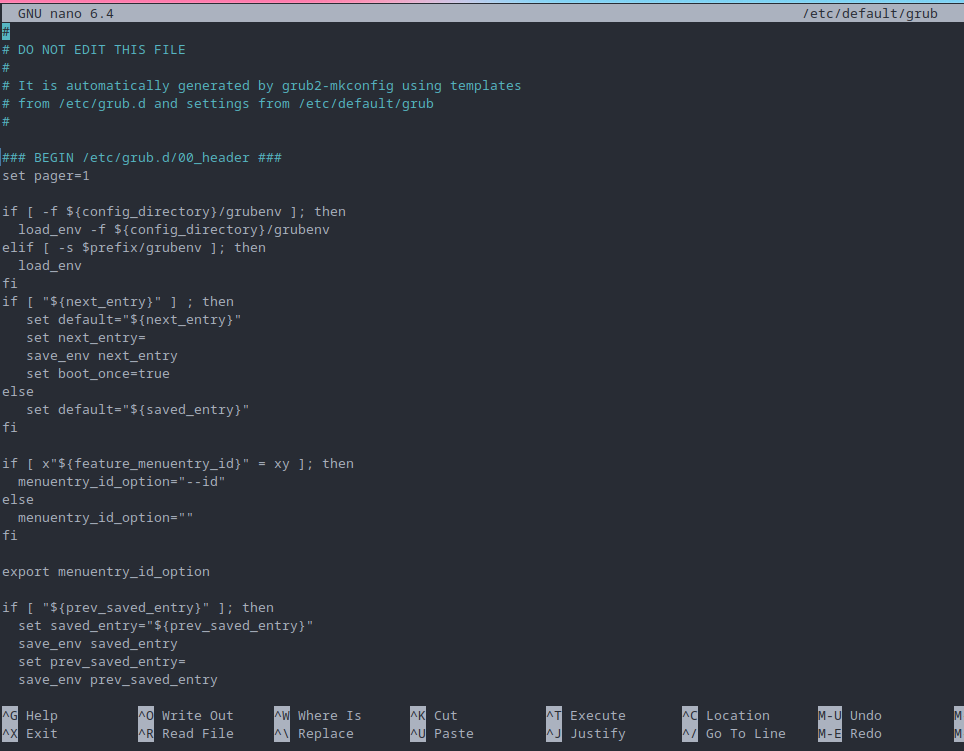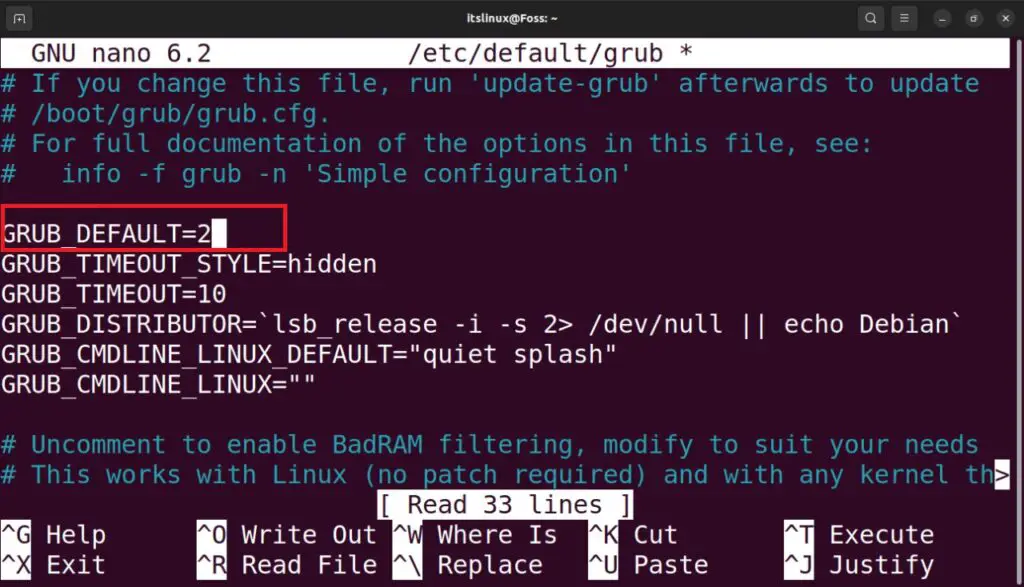I’m trying to update my grub boot order back to booting the first option instead of the second, so I run sudo nano /etc/default/grub, but it brings up this, which is not the file I want to edit.
I’m on fedora 38

This should get you back to defaults:
sudo cp /usr/share/grub/default/grub /etc/default/grub && sudo update-grubAt some point you definitely did accidentally write to /etc/default/grub when you meant to write to /boot/grub/grub.cfg.
There’s no shame in that; Grub’s configuration process is very confusing and counter-intuitive.
Everybody who has used Linux long enough has stories of breaking their systems in sillier ways, and this didn’t even really break your system 🙂.
THanks! but I’m getting the error
cp: cannot stat '/usr/share/grub/default/grub': No such file or directorywhen running this.What version of Ubuntu are you using?
What is the output of the following command?:
dpkg -l | grep grubIf you urgently want your grub menu to default to the first entry that can be done first, but unless that’s needed I’d prefer to get to the root of the problem(s) and get a proper fix.
I’m using fedora 38
Ahh, sorry.
For Fedora it looks like the default /etc/default/grub looks like this:
GRUB_TIMEOUT=5 GRUB_DISTRIBUTOR="$(sed 's, release .*$,,g' /etc/system-release)" GRUB_DEFAULT=saved GRUB_DISABLE_SUBMENU=true GRUB_TERMINAL_OUTPUT="console" GRUB_CMDLINE_LINUX="rhgb quiet" GRUB_DISABLE_RECOVERY="true" GRUB_ENABLE_BLSCFG=true( Taken from https://discussion.fedoraproject.org/t/how-to-regenerate-etc-default-grub/72677/9 )
If you’re using LVM / LUKS you may need additional kernel parameters, like resume=… for suspend to disk to work properly.
Please, before doing anything else, post the output of the following:
cat /proc/cmdlineAnd make a backup of your existing grub.cfg with:
sudo cp /boot/grub2/grub.cfg /boot/grub2/grub.cfg-backup-$(date --iso-8601=s)Also, be sure that you have a LiveUSB on hand. You don’t want to be SOL if we break something and can’t boot again without fixing it first.
Interstellar_1@pawb.social
Sorry again. I wrote this last comment (and this one, TBH) from my phone and “–iso=s” should have been “–iso-8601=s” . I’ve edited my comment and the command should now work (Making a backup of your grub.cfg containing the date, to the second, in the filename. I did that to hopefully avoid you running the same command again after trying some fixes and accidentally clobbering your backup).
This command doesn’t work for me
This looks like
grub2-mkconfigwas run with the output mistakenly set to/etc/default/grub. Someone rangrub2-mkconfig -o /etc/default/grubInstead of
grub2-mkconfig -o /boot/grub2/grub.cfgso I run
sudo nano /etc/default/grubFor improved security during file edits that require root access, it’s highly advised to use
sudoedit(orsudo -e). This method is considered the standard practice to avoid the security pitfalls associated with directly invoking editors withsudo. To ensure the use ofnanowithsudoedit, simply set theVISUALenvironment variable withexport VISUAL=nanobefore runningsudoedit. Alternatively, for a one-off command:VISUAL=nano sudoedit /path/to/file.Please note that while
sudoeditis a safer starting point, it’s not the only method available. Alternatives such asdoas,doasedit, or leveragingpolkitwithpkexeccan offer even more controlled and secure ways to manage file editing with elevated privileges. However, it’s perfectly acceptable to stick withsudoedit, as it’s a commonly trusted tool.Be aware that direct usage of
sudo nanoor other editors is strongly discouraged. It bypasses important security mechanisms and can lead to inadvertent system-wide risks.EDIT: changed
VISUAL=nano sudoedittoVISUAL=nano sudoedit /path/to/file.Removed by mod
I agree with the general sentiment. Thank you for mentioning that!
Though, the use of
sudo nanomight still pose a risk if any software found on the system is either vulnerable/exploitable, not trusted, or simply exploitative. In that case, like what’s achieved through sandboxing i.e. not allow the software to go beyond their intended scope, it makes sense to put a limit on the capabilities of the software. And to that effect, the use ofsudoeditstill offers merit oversudo nano.Though, if the user doesn’t (already) rely on bubblejail, firejail, Flatpak etc for what they offer in sandboxing. And/or if said user simply doesn’t care for the principle of least privilege, then the use of
sudo nanois perfectly valid.This isn’t a scenario I’m familiar with. How can I learn more?
Never heard of sudoedit. I want to experiment with a system where I
alias sudo=pkexec, VanillaOS does that
Somehow your
/etc/default/grubfile contents have been replaced with that of/boot/grub/grub.cfgThat looks like the grub file that’s put in /boot to make the menu to boot the system.
Are you sure you’ve never run “grub2-mkconfig -o /etc/default/grub”? Because making the grub file you may have overwritten the config file.
By the look of things I would reinstall grub with my package manager to forcing to overrun config files. Keep in mind this would return the file to your distribution defaults.
Removed by mod
deleted by creator
I didn’t do anything, I’m just trying to change my grub config
 This is what it’s supposed to look like
This is what it’s supposed to look likedeleted by creator
Something has definitely been buggered seven ways from sunday here. If you need it I’m willing to provide you my config which you could then paste in. I haven’t changed anything, just enabled OS prober. Take this as a last resort though.
What distro?
Fedora 38
Well, if you look at the file… and search the internet for “fedora edit grub entry not possible” that works.
You use grub2-mkconfig to create this file, and what you want to change it in another file that is used to create this one.
The thing is, what do you want to edit?
I want to edit the grub config, to change the default boot order
Did you already do an internet search? Positive you will find that answer





